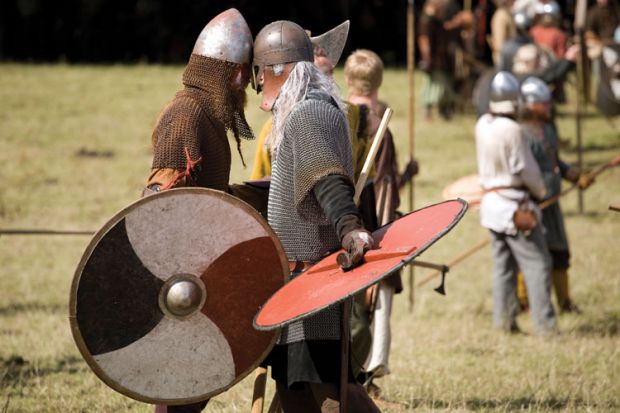Modern English has a rich and varied vocabulary for swearing. Those terms referring to the bodily, effluvial and sexual (cock, cunt, fuck, piss and shit) are commonly called Anglo-Saxon four-letter words. Yet very few of these words were Anglo-Saxon, and those that were certainly were not swear words. In fact, nothing that survives from Anglo-Saxon England could really be considered a swear word.
It’s easy to see why the idea has stuck. Calling such words “Anglo-Saxon” harks back to a familiar image of the medieval period as harsh, dirty and lawless. But just as that image is false, so too is the etymology. Only a small number of the words we consider profanity have Anglo-Saxon roots: arse, bollock, fart, shit and turd. The others are all later arrivals into the English language. Cock and piss come via Norman English, and bum, cunt, fuck and twat are of unknown origin and appeared from the 13th century onwards. There is, in fact, very little that could be considered profanity in the surviving corpus of Old English, the language of the Anglo-Saxons.
The language of a large proportion of the population of Anglo-Saxon England – the period from roughly AD500 to 1066 – has not been recorded, and so we have little idea how they spoke. Literate Anglo-Saxons were rare, restricted to a small elite of educated ecclesiastics, taught by the Church, and largely living within monastic communities. The writing they produced – or, at least, that which has survived – is restricted to documentary, legal and religious prose, and poetry with predominantly religious themes. There is little room in this corpus for outbursts of colloquial profanity.
Despite these limited contexts, sex, bodies and bodily functions were still written about. That is not to say there was no stigma attached to them: regardless of which words you use, defecation is always an unsavoury conversation topic, and certain behaviours, such as eating while on the toilet, are frowned upon. However, the Anglo-Saxon words for these things were no ruder than the modern English words coitus or defecation. They did not carry the extra taboo that fucking or shitting do. Taboo was firmly in the domain of the holy: swearing on God or blaspheming was taken very seriously. The language that survives on sexual or genital themes is either euphemistic (equivalent to modern English relieving oneself or sleeping together), or clinical and detached (effluvia, genitalia).
Scitte (“shit”) and tord (“turd”), for example, are found in an Old English medical text. Beallucas (“bollock”) and the various forms of ears (“arse”) – such as ears-ende and ears-þerl for buttocks and arse-muscle – are found in vocabulary lists translating Latin words. “Fart”, which is believed to have existed in Old English as feortan, does not survive in any written form, so we cannot gauge its rudeness. If more obscene words for these concepts existed, they do not survive.
While Anglo-Saxon terms for the effluvial were pragmatic and literal, words relating to sex were less direct. Perhaps the most euphemistic is cunnan, “to know”, which is still used today with the aid of a meaningful eyebrow to indicate salacious intent. Other familiar euphemisms include gemengan, “to mix, join or associate”; hæman, “to lie with someone in marriage”; and geþoftscipe, “intimacy, companionship or society”. The most explicit term, seorðan, was borrowed from Old Norse, but its exact translation is unclear. It is found in an Old English translation of Matthew v, (“You shall not commit adultery”). The phrase “ne serð ðu oðres monnes wif” means “do not [something] another man’s wife”, but modern translations of serð are uncertain, ranging from “lie with” to “violate”. By the 15th century, it had become sard, which was certainly obscene and equivalent to fuck, but its appearance in a biblical context suggests that it was not so in Old English.
The lack of surviving profanity from Anglo-Saxon England is unusual. We know from contemporary Old Norse texts that there was no shortage of creative and explicit profanity in wider Germanic culture. The Landnámabók, or The Book of Settlements, contemporary with the end of the Anglo-Saxon period, features an array of bynames, akin to nicknames, bestowed on individuals that identify them in some way, such as Ragnar Loðbrok, “Ragnar Hairy-Trousers”. Alongside mundane examples focusing on trade or general characteristics appear the more surprising beytill, “Banger, Horse Penis”; hnappraz, “button arse”; knarrarbringa, “merchantship-bosom, or big-tits”; kortr, “short penis”; and meinfretr, “stink-fart, or harmful-fart”. Unlike the Old English words, these names are not literal or clinical, and they are certainly not euphemistic. Perhaps they reveal a healthy enjoyment of the bodily and the sexual.

However, euphemism and a lack of explicit vocabulary were no hindrance to smut. Innuendo is taken to its poetic extreme in the Exeter Book riddles, a group of texts in a 10th-century manuscript of quite serious poetry given by Bishop Leofric to Exeter Cathedral. As a whole, the riddles cover everyday subjects, including the weather and the natural world, in short verses without solutions. Later readers have attempted to solve these, and a small selection appear to have dual solutions: one innocent, one decidedly not. Consider the following (in my own translations):
I am a wonderful creature, I bring joy to women
And am useful to those nearby; I harm
No one except my destroyer.
My position is high; I stand up in bed;
Beneath, in my hidden place, I am hairy. Sometimes
The beautiful daughter of a poor man,
A courageous girl, will get a grip on me.
She assaults my redness, takes my head,
And holds me tight. She will soon feel
The effect of meeting me, of being near me
This curly-haired woman. Her eye will become wet.
(Riddle 25)
I know of something growing in a corner,
Swelling and standing up, lifting its covering;
On that boneless thing, a young woman
Proudly gripped with her hands; with her apron
A lord’s daughter covered the swollen thing.
(Riddle 45)
The thing described by the first riddle is, of course, an onion. The second is dough rising.
These two are part of a group of bawdy riddles concerned chiefly with phallic imagery (a key, a poker, a head going into a shirt), perhaps reflecting the sex of their monastic authors. A notable exception is Riddle 12, which is focused on female sexuality. Narrated in the voice of an ox, it lists a series of objects undisputedly made of its hide: leather straps, a drinking vessel and shoes. The next item, however, is unclear. Depending on the interpretation, it could be something entirely innocuous or an ox-hide dildo used by a servant girl for masturbation. While unusual, this interpretation is not without precedent: Nina Rulon-Miller points to a rule in the penitentials of Bede that decrees, “If a nun fornicated with a nun by means of a device, she is to do penance for seven years”, and a Norse story involving a servant girl and a horse’s penis.
The language of these riddles is not in itself obscene, and their purpose is unknown. They may have been included in the manuscript for the simple purpose of amusement, or perhaps their double meaning was intended to force readers to reveal their dirty minds in response to a seemingly clean text. In any event, it is clear that each word, while seemingly innocent, is chosen with the deliberate intention of innuendo and with a precise awareness of the power of the language being used.
While terms for genitalia, sex and effluvia were not explicitly profane or taboo in Anglo-Saxon England, the writers of Old English, despite their monastic background, were part of a wider culture that took great enjoyment in these subjects and found creative ways of communicating their salacious or bawdy intent. If more profane language existed, it did not survive. Yet the examples show that it was not necessary to get the desired meaning across. The Anglo-Saxons could still be rude without four-letter words.
Register to continue
Why register?
- Registration is free and only takes a moment
- Once registered, you can read 3 articles a month
- Sign up for our newsletter
Subscribe
Or subscribe for unlimited access to:
- Unlimited access to news, views, insights & reviews
- Digital editions
- Digital access to THE’s university and college rankings analysis
Already registered or a current subscriber? Login

